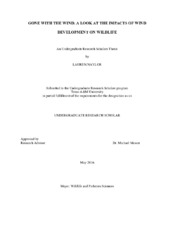| dc.description.abstract | Climate change is an ever-growing problem that has gained increased public and political attention in recent years. Energy production is one of the major sectors that influence our overall emission rates that contribute to climate change. One of the potential solutions lies in an increased development of wind energy. Wind energy offers a cleaner production alternative that not only helps to reduce emissions, but that will also increase the diversity of our nation’s energy portfolio. Wind energy does not, however, come without its own costs. The potential negative impacts of widespread wind energy development need to be carefully considered.
The question this project intends to answer is, with regard to injuries sustained by birds of prey as a result of direct collisions with wind farms, how many of the affected birds can be rehabilitated, and what level of recovery they most often reach. The project will consist of three major parts: a literature review, survey data, and post-survey interviews. The literature review will be used to develop background knowledge of the potential negative impacts that wind development may have on wildlife populations, specifically those of raptors. Raptors were chosen because of their slow reproductive cycles and long lifespans, relative to other bird species. The second phase will consist of a survey that will be sent out to raptor rehabilitation centers in the six states that contain the largest percentage of wind development (Texas, Oregon, Washington, California, Iowa and Minnesota). This survey will provide a new source of data by addressing local rehabbers, and thereby exploring a local aspect of the human dimension that is often overlooked. The last phase of this project will involve evaluating the opinion of experts in the field. The objective of these separate steps is to integrate biological and social sciences through the analysis of both peer-reviewed literature and local knowledge (i.e. information gained from surveys and interviews), in order to create a more comprehensive picture of a problem and its potential solutions. | en |


